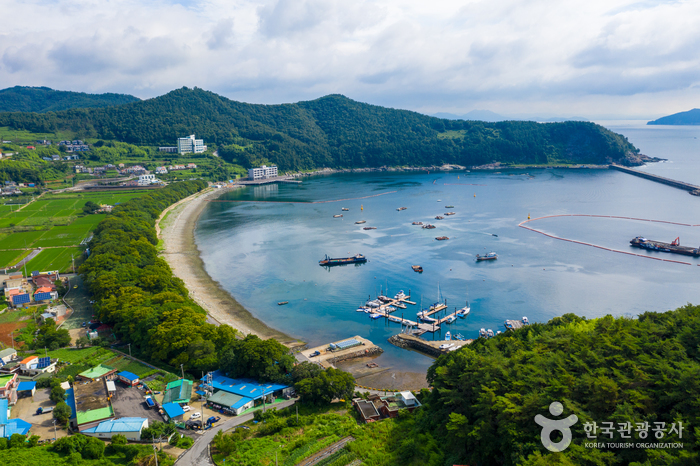Welcome to Mulgeon Windbreak Forest: Where Nature Meets Serenity
Welcome to Mulgeon Windbreak Forest, a hidden gem nestled in the breathtaking coastal town of Namhae in Gyeongsangnam-do, South Korea. With its picturesque coastal lines stretching over 302 kilometers and surrounded by 70 beautiful islands, Namhae is a dream come true for nature lovers and those seeking a tranquil escape. Within this enchanting destination, the Mulgeon Windbreak Forest stands as a testament to the harmonious relationship between humans and nature, providing protection from gusty winds and ferocious waves for over 300 years.
A Natural Haven Shaped Like a Crescent Moon
Spanning across a spacious area of 23,438 square meters along the seashore, the Mulgeon Windbreak Forest, owned by the community of Mulgeon-ri, resembles a crescent moon embracing the coastline. Stretching over 1.5 kilometers with a width of 30 meters, this expansive forest is home to more than 2,000 trees, each boasting a majestic height of 10 to 15 meters. Among the diverse array of trees, you’ll find hackberries, oaks, zelkovas, fringe trees, muku trees, and silver magnolias, creating a captivating canopy that transports you to an ancient forest hidden deep within the mountains. In total, approximately 10,000 trees thrive within this natural wonderland.
A Historical Legacy of Protection and Preservation
The Mulgeon Windbreak Forest holds a rich history that dates back 300 years when it was built by the people of nearby villages to control winds and waves. From above, the forest’s lush trees gracefully encircle the elegant curvilinear coastal lines, providing a protective barrier against the mighty Namhae Sea. Mulgeon-ri, the village surrounding the forest, is divided into two distinct areas: the port, adorned with a charming lighthouse, and lush farmlands. The Windbreak Forest stands gracefully in between, serving as a living testament to the harmonious coexistence of humans and nature.
A Forest of Many Names with Countless Wonders
This extraordinary forest is known by a variety of names, each capturing its unique features and contributions to the region. Locally, it is called “Bangpungrim” or the Windbreak Forest, symbolizing its role in protecting nearby villages from gusty winds. The lush vegetation within the forest has also earned it the name “Eoburim” or the Fish Shelter Forest, as it attracts abundant schools of fish. Additionally, the Windbreak Forest is referred to as “Bangjorim,” the Waterbreak Forest, for its ability to lessen the severity of waves and tides. As you explore the forest, you’ll discover the wonders that have captivated visitors for centuries.
Awe-Inspiring Sunrises and Sunsets
Located in Mulgeon-ri, which faces eastward, the Windbreak Forest offers a front-row seat to witness nature’s spectacular performances of sunrise and sunset. While Jeongdongjin on the East Coast is renowned for its splendid sunrise, Mulgeon-ri shares the same acclaim on the South Coast. As the dawn of every New Year approaches, thousands of visitors are drawn to this magical spot to witness the mesmerizing spectacle of the rising sun, painting the sky with vibrant hues and casting a golden glow over the tranquil forest.
How to Get Here
If you’re traveling from Seoul, hop on an intercity bus from Seoul Nambu Bus Terminal to Namhae. From Namhae Intercity Bus Terminal, you can then easily catch a bus bound for Mulgeon Windbreak Forest. The journey itself offers glimpses of the stunning landscapes that await you, setting the stage for an unforgettable experience.
Are you ready to immerse yourself in the beauty of Mulgeon Windbreak Forest? Prepare to be captivated by the harmonious blend of nature, history, and tranquility that awaits you in this remarkable destination. Pack your bags, embrace the serenity, and embark on a journey of exploration and wonder.

